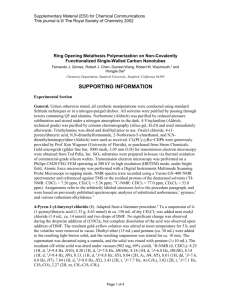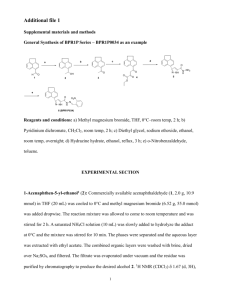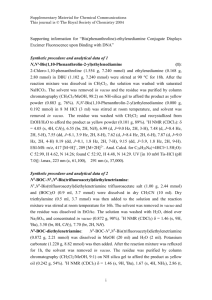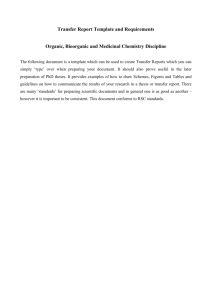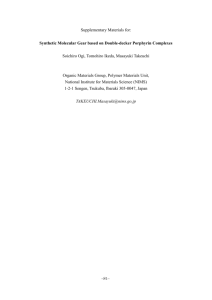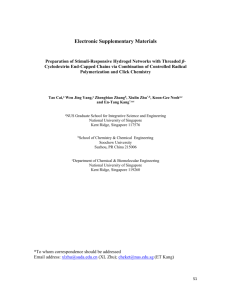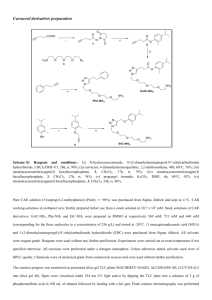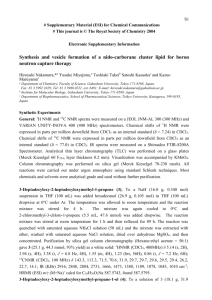Supplementary data - Royal Society of Chemistry
advertisement
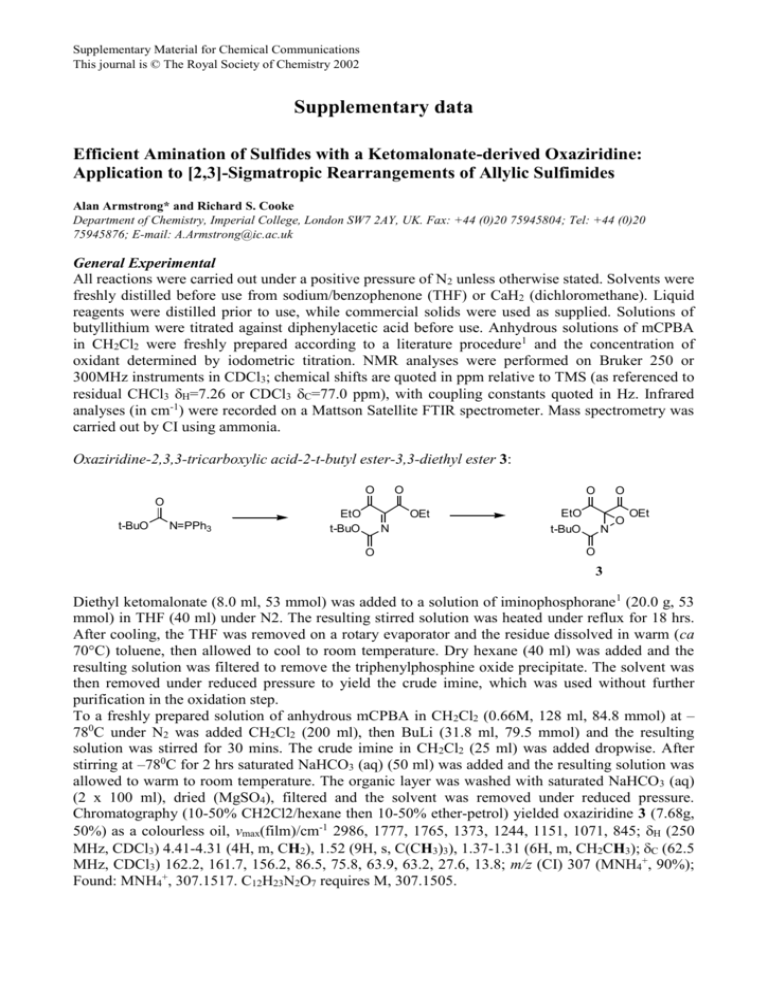
Supplementary Material for Chemical Communications This journal is © The Royal Society of Chemistry 2002 Supplementary data Efficient Amination of Sulfides with a Ketomalonate-derived Oxaziridine: Application to [2,3]-Sigmatropic Rearrangements of Allylic Sulfimides Alan Armstrong* and Richard S. Cooke Department of Chemistry, Imperial College, London SW7 2AY, UK. Fax: +44 (0)20 75945804; Tel: +44 (0)20 75945876; E-mail: A.Armstrong@ic.ac.uk General Experimental All reactions were carried out under a positive pressure of N2 unless otherwise stated. Solvents were freshly distilled before use from sodium/benzophenone (THF) or CaH2 (dichloromethane). Liquid reagents were distilled prior to use, while commercial solids were used as supplied. Solutions of butyllithium were titrated against diphenylacetic acid before use. Anhydrous solutions of mCPBA in CH2Cl2 were freshly prepared according to a literature procedure1 and the concentration of oxidant determined by iodometric titration. NMR analyses were performed on Bruker 250 or 300MHz instruments in CDCl3; chemical shifts are quoted in ppm relative to TMS (as referenced to residual CHCl3 H=7.26 or CDCl3 C=77.0 ppm), with coupling constants quoted in Hz. Infrared analyses (in cm-1) were recorded on a Mattson Satellite FTIR spectrometer. Mass spectrometry was carried out by CI using ammonia. Oxaziridine-2,3,3-tricarboxylic acid-2-t-butyl ester-3,3-diethyl ester 3: O O O O O t-BuO N=PPh3 EtO t-BuO OEt N O EtO t-BuO N O OEt O 3 Diethyl ketomalonate (8.0 ml, 53 mmol) was added to a solution of iminophosphorane1 (20.0 g, 53 mmol) in THF (40 ml) under N2. The resulting stirred solution was heated under reflux for 18 hrs. After cooling, the THF was removed on a rotary evaporator and the residue dissolved in warm (ca 70°C) toluene, then allowed to cool to room temperature. Dry hexane (40 ml) was added and the resulting solution was filtered to remove the triphenylphosphine oxide precipitate. The solvent was then removed under reduced pressure to yield the crude imine, which was used without further purification in the oxidation step. To a freshly prepared solution of anhydrous mCPBA in CH2Cl2 (0.66M, 128 ml, 84.8 mmol) at – 780C under N2 was added CH2Cl2 (200 ml), then BuLi (31.8 ml, 79.5 mmol) and the resulting solution was stirred for 30 mins. The crude imine in CH2Cl2 (25 ml) was added dropwise. After stirring at –780C for 2 hrs saturated NaHCO3 (aq) (50 ml) was added and the resulting solution was allowed to warm to room temperature. The organic layer was washed with saturated NaHCO3 (aq) (2 x 100 ml), dried (MgSO4), filtered and the solvent was removed under reduced pressure. Chromatography (10-50% CH2Cl2/hexane then 10-50% ether-petrol) yielded oxaziridine 3 (7.68g, 50%) as a colourless oil, vmax(film)/cm-1 2986, 1777, 1765, 1373, 1244, 1151, 1071, 845; H (250 MHz, CDCl3) 4.41-4.31 (4H, m, CH2), 1.52 (9H, s, C(CH3)3), 1.37-1.31 (6H, m, CH2CH3); C (62.5 MHz, CDCl3) 162.2, 161.7, 156.2, 86.5, 75.8, 63.9, 63.2, 27.6, 13.8; m/z (CI) 307 (MNH4+, 90%); Found: MNH4+, 307.1517. C12H23N2O7 requires M, 307.1505. Supplementary Material for Chemical Communications This journal is © The Royal Society of Chemistry 2002 Amination experiments in Table 1 To a stirred solution of oxaziridine (0.035 mmol) in solvent (1 ml) at the required temperature under N2 was added thioanisole (3.9 mg, 0.035 mmol) dropwise in solvent (1 ml). The solution was allowed to warm to room temperature and then the solvent was removed under reduced pressure. The ratio of amination to oxidation was determined by NMR analysis of the crude product. Typical Procedure for amination (and rearrangement), Tables 2 and 3 To a stirred solution of oxaziridine 3 (250 mg, 0.86 mmol) in CH2Cl2 (5 ml) at –400C was added dropwise a solution of sulfide (0.82 mmol) in CH2Cl2 (5 ml). The resulting solution was allowed to warm to room temperature over 30 mins and then the solvent was removed under reduced pressure. Chromatography (2% MeOH : EtOAc) yielded required product. Data for sulfides2 and allylic amine derivatives3 were in agreement with literature values. Allylic Sulfide Preparation All allylic sulfides were prepared by and gave data consistent with references provided by Bach.3 1 H NMR spectrum (250MHz, CDCl3) of oxaziridine 3: O OEt O NBoc EtO 10 O 9 8 7 6 5 4 3 2 1 References 1. J. Vidal, S. Damestoy, L. Guy, J. Hannachi, A. Aubry, and A. Collet, Chem. Eur. J. ,1997, 3, 1691. 2. T. Bach and C. Körber, Eur. J. Org. Chem., 1999, 1033. 3. T. Bach and C. Körber, J. Org. Chem., 2000, 65, 2358.
